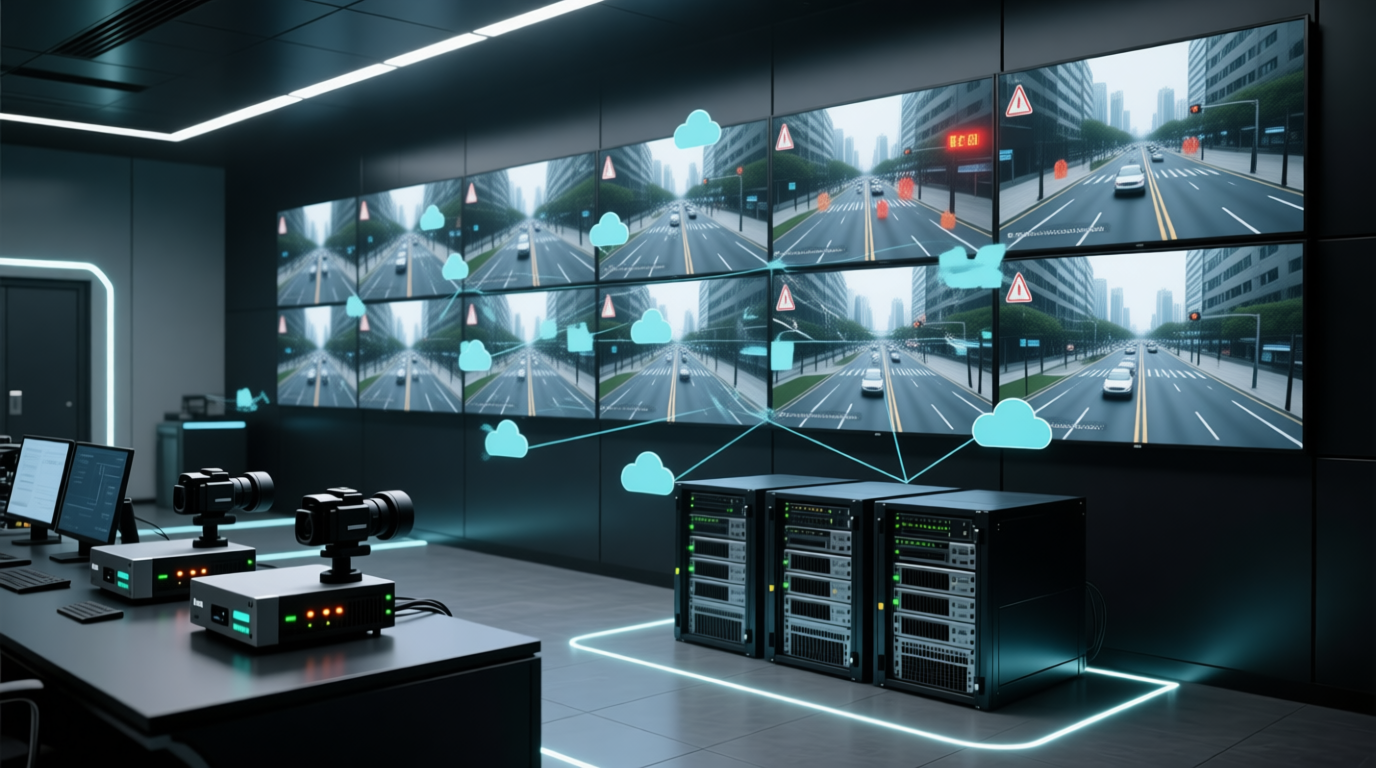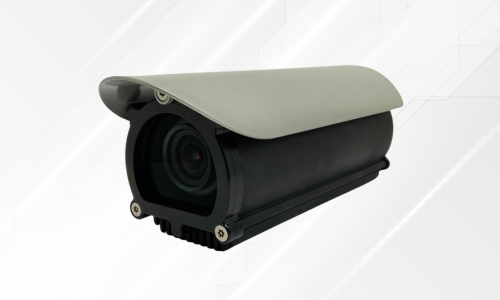The Benefits of Edge AI for Real-Time Surveillance Analytics
Modern surveillance environments generate enormous streams of visual data every moment, and traditional systems that rely on centralized cloud processing often struggle with bandwidth limits, latency issues, and privacy concerns. This is where Edge AI becomes a transformative enabler, helping surveillance systems process video data on-site rather than sending every frame to remote servers, providing lightning-fast analytics and actionable insights.
modern edge AI surveillance control room processing real-time video analytics with smart sensors and on-site compute devices
The rise of smart sensors, computer vision, and Artificial Intelligence has reshaped the expectations of surveillance. Stakeholders now demand real-time alerts, automated event recognition, object detection, anomaly prevention, license plate recognition, and advanced behavioral analytics.
In this article, we explore the benefits of Edge AI for real-time surveillance analytics, how organizations are integrating it into existing environments, and why this shift matters for the next generation of physical security.
What is Edge AI in Surveillance?
Edge AI refers to the practice of processing intelligence on local devices such as cameras, compute nodes, or gateways rather than relying on external cloud servers. Instead of transmitting live video streams over the network, Edge AI systems analyze frames locally and only send relevant results, metadata, or alerts.
This architecture offers several immediate advantages, including
Lower latency
Reduced bandwidth consumption
Better data privacy
Improved reliability in network-constrained environments
In surveillance, Edge AI enables on-device analytics such as
Object detection
Facial blurring for privacy compliance
License plate recognition (LPR)
Vehicle make, model, and color classification (MMCG)
Intrusion detection
Loitering detection
Because processing happens locally, responses are nearly instant. Security personnel can act faster on suspicious behavior, unusual movement, or parking violations.
Why Traditional Cloud-Based Surveillance Struggles
Most legacy surveillance systems send live video feeds to centralized servers for storage and processing. While functional, this approach introduces several critical bottlenecks.
cloud-based surveillance system lagging with network congestion and bandwidth issues in the security operations center
1. High Bandwidth Costs
Streaming high-resolution video continuously consumes large network resources, especially when scaled across dozens or hundreds of cameras.
2. Latency
Cloud round-trip creates delays that can impact real-time decision-making. In security, a delay of even five to ten seconds can be costly.
3. Privacy Risks
Depending solely on cloud processing may not align with regulations like GDPR or CCPA that regulate personally identifiable information (PII), such as faces or license plates.
4. Server Overload
Centralized servers bear the burden of processing every frame, resulting in performance degradation.
5. Single Point of Failure
If network connectivity drops, the entire surveillance operation can lose analytic visibility.
Edge AI significantly reduces these weaknesses by distributing intelligence to multiple devices at the perimeter.
Core Benefits of Edge AI for Real-Time Surveillance Analytics
1. Ultra Low Latency Response
When analytics run at the edge, the system responds instantly. Instead of relying on remote inference, the camera or compute node identifies threats locally. This makes it ideal for:
Real-time access control
Perimeter intrusion
Retail theft prevention
Parking violations
Traffic event detection
Organizations can prevent incidents rather than merely record them.
“In real-time surveillance, speed is not an optimization; it is a requirement.”
2. Reduced Bandwidth Consumption
Transmitting full-resolution video continuously is expensive. Edge AI reduces this load by sending only:
Alerts
Metadata
Keyframes
This is especially beneficial in:
Remote sites
Smart city deployments
Wide area networks
Mobile surveillance units
3. Enhanced Privacy & Compliance
Regulators worldwide are adopting stricter rules on surveillance footage and biometric data. Edge AI protects privacy by redacting or anonymizing sensitive information on site. This minimizes exposure and aligns with regulations such as:
GDPR
CCPA
HIPAA (in healthcare environments)
Sighthound Redactor supports automated masking of sensitive elements, reinforcing compliance across industries.
4. Improved System Reliability
Since analytics occur locally, operations continue even if network links are unstable. Enterprises maintain:
Critical alerts
Real-time detection
Evidence logs
Without waiting for cloud connectivity to return.
5. Scalability Without Infrastructure Overload
Adding more cameras to a cloud-only system increases central processing load. With Edge AI, each device processes its own data, enabling infinite scale by distribution rather than consolidation.
6. Lower Operational Costs
On-site inference saves costs related to:
Cloud compute cycles
Data storage
Bandwidth charges
It also reduces the need for expensive backend servers.
7. Faster Forensic Search
Metadata tags generated at the edge improve investigative workflows. Security operators can search:
Vehicle types
Colors
License plates
Times
Behavioral patterns
in seconds instead of reviewing hours of footage manually.
Use Cases for Edge AI Surveillance Analytics
Smart Cities
Smart cities rely on large camera networks to keep roads safe, reduce congestion, and improve the citizen experience. Municipal authorities often struggle to monitor thousands of live feeds, which makes manual oversight impractical. Edge AI solves this by processing video at the camera source, then delivering instant insights instead of raw footage.
smart city intersection using edge AI for traffic and pedestrian monitoring with real-time vehicle detection
For traffic management, edge models can classify vehicles by type, detect accidents, and identify road violations in real time. Parking enforcement also becomes more efficient because the system can recognize illegal parking habits, overstays, or blocked exits the moment they occur. Pedestrian flow monitoring helps planners understand crowd movement, especially during public events, allowing them to optimize safety barriers, road closures, and emergency routes.
Real-world context: Many European smart cities have reduced congestion by automatically detecting bus lane misuse and rerouting traffic when bottlenecks appear. Without edge analytics, operators would rely on slower manual review.
Airports
Airports operate under strict security standards and face unique threats due to their layout and passenger volume. Edge AI provides instant detection of objects or behavior that could signal risk, ensuring rapid response before escalation.
Modern airport terminal scene with AI-highlighted detection of unattended luggage
Abandoned objects can indicate hazardous intent or passenger forgetfulness. Edge models flag items that remain unattended beyond a time threshold, notifying staff as soon as possible. Restricted zone entry is another core challenge. When unauthorized individuals cross line boundaries, security teams receive alerts immediately. Vehicle anomalies, such as unauthorized airside vehicle movement, are also identified automatically to prevent runway incidents.
Real-world context: Many major airports now use AI for unattended baggage alerts, significantly reducing emergency evacuations caused by false alarms.
Retail
Retail environments face constant challenges from shrinkage, including theft, misplacement, and operational errors. Edge AI reduces loss by analyzing behavior patterns rather than depending on resource-heavy human monitoring.
Shelf theft detection identifies when items are repeatedly taken or hidden, rather than being scanned. Suspicious loitering alerts staff when individuals remain in high-risk zones without a clear shopping intention. Inventory tagging errors, such as misplaced SKUs or incorrectly labeled shelves, are identified through pattern recognition, which improves stock discipline and the shopper experience simultaneously.
Real-world context: Supermarket chains have reported saving millions annually by using AI to detect repeat incidents of shelf-sweeping, where entire rows are emptied within seconds.
Traffic and Law Enforcement
Law enforcement requires accurate and fast license plate identification in many situations, including toll management, wanted vehicle detection, and insurance compliance. Edge-based Automatic License Plate Recognition (ALPR) delivers results instantly at the camera level, without sending video to the cloud.
Real-time plate capture improves responsiveness during pursuits or active alerts. Violation alerts automatically notify authorities when vehicles run red lights or make illegal turns. Fraud detection identifies cloned plates or spoof attempts by comparing metadata patterns, making investigations more credible.
Because all analysis happens locally, latency is significantly reduced, which is pivotal for enforcement actions that require immediate intervention.
Integrating Edge AI With Existing VMS Solutions
When organizations want to adopt Edge AI for surveillance analytics, they usually do not start from scratch, Most companies already have a Video Management System, also called VMS, that stores and displays camera feeds, VMS platforms can include features like recording, playback, motion detection, and user permissions, Because these systems already run at scale, replacing them entirely can be expensive, disruptive, and time consuming, Instead, Edge AI can be added on top of the existing infrastructure, boosting intelligence without interrupting daily operations
How Edge AI outputs integrate
Edge AI devices can pass analytics results into existing VMS platforms through several standardized pathways. Some of the most common include:
ONVIF metadata streams
ONVIF is a universal interoperability standard for video and metadata. Edge devices can embed analytics results inside the video stream, such as bounding boxes or object labels. The VMS reads this metadata and can trigger events based on it
RTSP overlays
RTSP is a standard protocol for video streaming. Edge devices can overlay analytics like object counts, bounding boxes, or alerts directly on the video feed. The VMS sees these visual cues without special integration code
Webhooks
A webhook is a small message that the edge device sends when a significant event occurs. For example, if a person is hooked to the VMS or an external system. This enables instant notification workflows
Event APIs
APIs allow direct software communication between the edge analytics engine and the VMS. The VMS can receive alerts, search metadata, and create automated actions through API calls. This approach is highly flexible and scalable.
Future-Proof Surveillance with Sighthound Compute Hardware
Edge AI is no longer a concept of the future; it's happening now. For businesses and law enforcement agencies looking to enhance surveillance, improve response times, and reduce costs, integrating Edge AI with Sighthound Compute Hardware is the next step.
Sighthound Compute Hardware
With Sighthound's AI-powered cameras and compute nodes, organizations can deploy high-performance, real-time surveillance that works seamlessly in any environment. Whether it's license plate recognition, facial detection, or anomaly monitoring, Sighthound Compute Hardware ensures faster insights, greater security, and smarter automation, all while keeping sensitive data private and secure.
For business opportunities, explore our Partner Program today.





